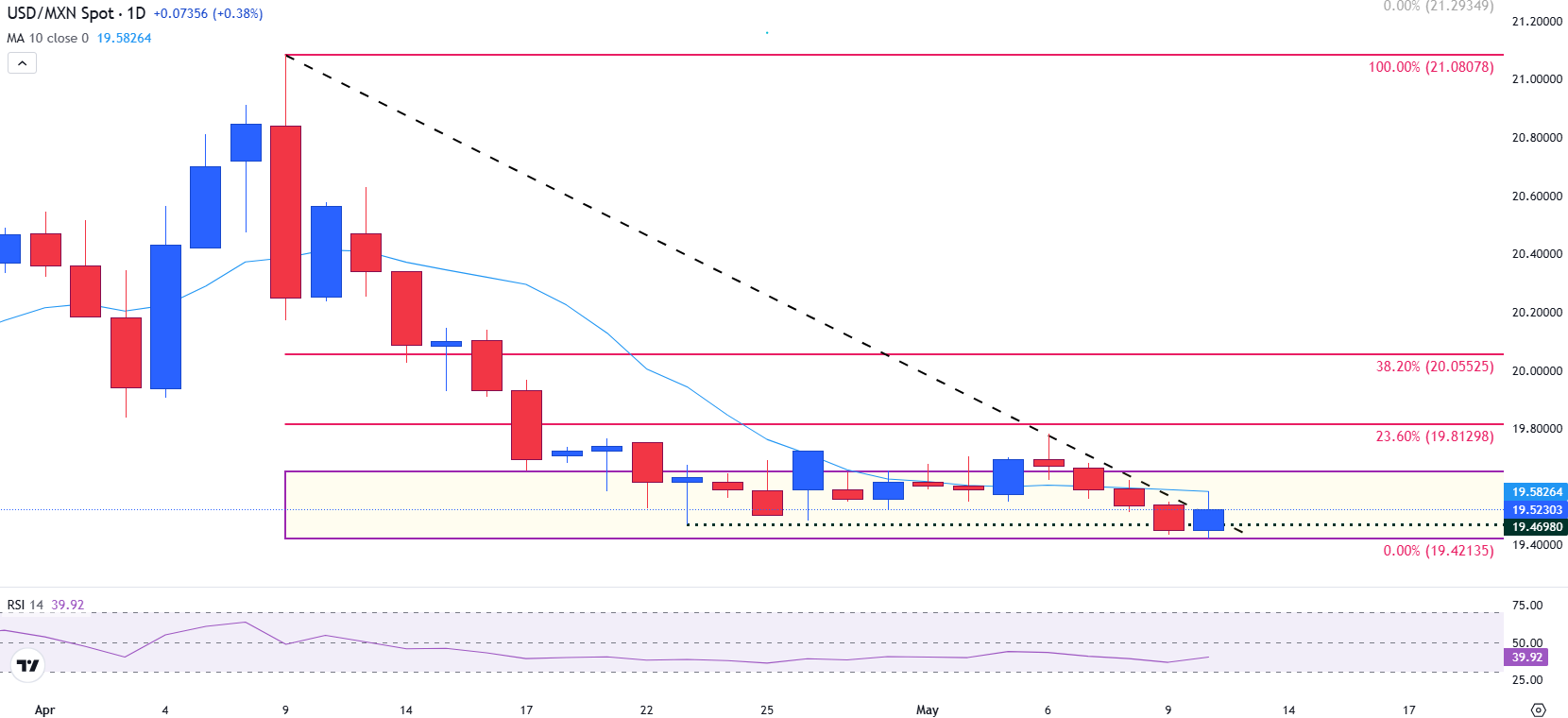Mexican Peso weakens as US growth outlook lifts USD after US-China trade deal

- The Mexican Peso weakens as the US Dollar strengthens on US-China trade deal optimism.
- The US-China trade deal to lower tariffs for 90 days lifts demand for the Greenback.
- USD/MXN tests trendline resistance after rebounding from May lows.
- Banxico is expected to cut rates as the Fed holds steady, narrowing the yield gap and supporting USD/MXN rise.
The Mexican Peso (MXN) is trading lower against the US Dollar (USD) during Monday’s European session, weighed down by rising demand for the Greenback following a breakthrough in US–China trade talks and ongoing Banco de Mexico (Banxico) policy easing.
At the time of writing, USD/MXN is trading around 19.52, up 0.37% on the day, as investors shift focus to Thursday’s Banxico policy decision and broader implications of US tariff policy on Mexican exports.
US–China truce lifts demand for the US Dollar, weighs on the Peso
On Monday, the United States and China announced a 90-day suspension of escalating tariffs, providing a temporary reprieve to global trade tensions. The deal has boosted market sentiment and eased concerns over a US-led recession, reinforcing expectations that the Federal Reserve (Fed) may have more room to keep interest rates elevated if economic conditions remain firm.
In contrast, Mexico’s economy remains under pressure from existing US tariffs on aluminium, steel, and autos. These 25% import duties have increased the cost of Mexican goods in US markets, threatening competitiveness and placing strain on export-driven industries. Local data and commentary from policymakers have increasingly reflected these challenges, showing signs of a broader economic slowdown.
In response, Banxico has pursued a dovish monetary path, cutting interest rates at six consecutive meetings to support growth and mitigate external pressures. A further 50 basis-point (bps) cut is expected at Thursday’s rate decision, which would further narrow the interest rate differential between Mexico and the US.
Mexican Peso daily digest: Mexican Industrial Output in focus
- Mexican industrial output data for March, scheduled for release at 12:00 GMT, will be closely watched for signs of strain in Mexico’s manufacturing sector.
- Weaker-than-expected figures could reinforce expectations for further Banxico easing and weigh on the Peso.
- With US yields remaining elevated and Mexico’s policy outlook turning increasingly accommodative, capital flows have continued to favour the US Dollar, exacerbating downside pressure on the Peso.
- US Treasury Secretary Scott Bessent and Trade Representative Jamieson Greer met with Chinese Vice Premier He Lifeng in Geneva over the weekend, where both sides reported progress. He described the talks as “candid and constructive,” while the US said “substantial progress” was made toward resetting trade relations.
- The US agreed to cut tariffs on Chinese imports from 145% to 30% for 90 days, providing relief to global supply chains.
- Beijing committed to lowering tariffs on US goods from 125% to 10% and announced the suspension of key retaliatory countermeasures.
- At 14:25 GMT, Fed Governor Adriana Kugler will speak at the NABE-Central Bank of Ireland Symposium in Dublin, with investors watching for policy signals amid a steady economic backdrop.
- According to the CME FedWatch Tool, there is a 92.1% probability that the Federal Reserve will keep rates steady at 4.25–4.50% in June, with the first 25 bps rate cut now only priced for September.
- In contrast, Banxico has cut rates at six consecutive meetings and is expected to continue easing, adding pressure on the Peso via a narrowing interest rate differential.
USD/MXN tests trendline resistance
USD/MXN remains confined within a narrow consolidation range above the key support at 19.42, with price action largely sideways in early May trading. The pair is currently testing a descending trendline resistance drawn from the April high, aligning closely with the 10-day Simple Moving Average (SMA) at 19.58, which has capped multiple upside attempts over the past two weeks.
USD/MXN continues to oscillate within a horizontal consolidation zone roughly between 19.42 and 19.65, with a cluster of candles suggesting indecision as bulls attempt to reclaim short-term control. A breakout above the trendline could signal a bullish reversal, potentially opening the path toward the 23.6% Fibonacci retracement level, drawn from the April 9 high of 21.08 to Monday’s low of 19.42, at 19.81, with the 38.2% Fibonacci retracement as the next resistance level at 20.05.
USD/MXN daily chart

On the downside, failure to break above trendline resistance could see renewed selling pressure, with key support holding at 19.42 (April low) and further downside risk toward 19.30–19.20 if the zone fails.
Momentum remains neutral to slightly bearish, with the Relative Strength Index (RSI), a momentum indicator, currently reading 41.16, still below the 50 midpoint, reflecting weak buying pressure. A sustained RSI move above 50 would be needed to confirm improving bullish momentum.
Tariffs FAQs
Tariffs are customs duties levied on certain merchandise imports or a category of products. Tariffs are designed to help local producers and manufacturers be more competitive in the market by providing a price advantage over similar goods that can be imported. Tariffs are widely used as tools of protectionism, along with trade barriers and import quotas.
Although tariffs and taxes both generate government revenue to fund public goods and services, they have several distinctions. Tariffs are prepaid at the port of entry, while taxes are paid at the time of purchase. Taxes are imposed on individual taxpayers and businesses, while tariffs are paid by importers.
There are two schools of thought among economists regarding the usage of tariffs. While some argue that tariffs are necessary to protect domestic industries and address trade imbalances, others see them as a harmful tool that could potentially drive prices higher over the long term and lead to a damaging trade war by encouraging tit-for-tat tariffs.
During the run-up to the presidential election in November 2024, Donald Trump made it clear that he intends to use tariffs to support the US economy and American producers. In 2024, Mexico, China and Canada accounted for 42% of total US imports. In this period, Mexico stood out as the top exporter with $466.6 billion, according to the US Census Bureau. Hence, Trump wants to focus on these three nations when imposing tariffs. He also plans to use the revenue generated through tariffs to lower personal income taxes.



